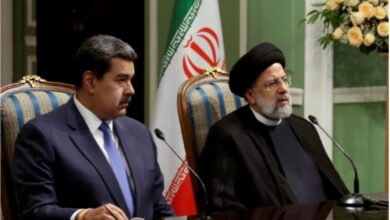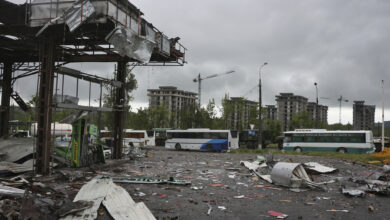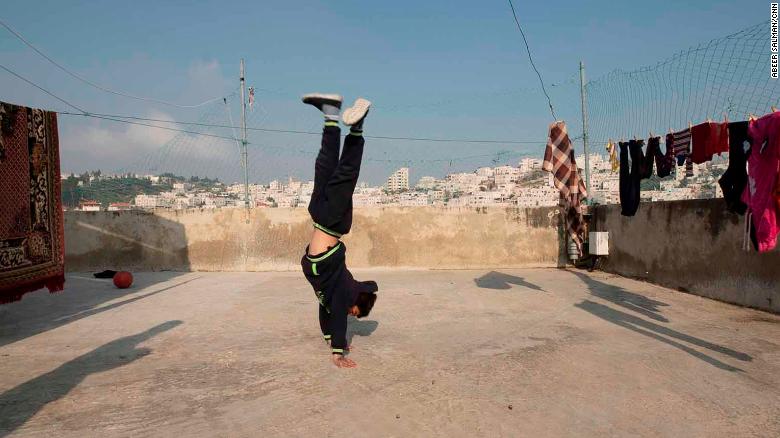
An exhibition entitled “Resistance" opened Saturday night, celebrating the third anniversary of Darb 1718, an art center in Old Cairo.
Coincidentally, the opening date also marked the one-year anniversary of the day 26-year-old Tunisian fruit seller Mohamed Bouazizi set himself ablaze, a symbolic act of defiance against state authorities after the confiscation of his vending cart. This event is considered the spark that ignited the wave of uprisings in the Arab world, many of which continue today.
Closer to home, only a few kilometers from the culture center in Old Cairo, violent clashes continue between protesters and Egypt’s military. This fact certainly added anxiety to the experience of viewing the exhibition.
The exhibition tries to capture the spirit of resistance through the works of six artists from Egypt, Saudi Arabia and Iraq.
“As Foucault says, resistance should be a natural part of everyday life, as it is required for us to evolve into stronger human beings with better ideas,” says Moataz Nasr El Din, the founder of Darb 1718 and an artist participating in “Resistance.”
“This concept is new to Egypt, and I think we are now learning how to incorporate resistance into our culture and values.”
The artwork on display offers engaging insights about the nature of resistance as a concept, and allows room for interpretation.
One installation by Egyptian artist Karim al-Tobgy, entitled “The Revealer,” speaks to the importance of moral values when working to resist the status quo in an informed manner.
The installation requires viewers to pick up a flashlight before entering a dark room where small flashlights are dangling from the ceiling. Each flashlight has a stencil fixed to it that illuminates a certain word on the wall in Arabic. The words include “Truth,” “Vision,” “Independence” and “Awareness,” symbolizing how the only way through the current darkness — particularly in relation to the current parliamentary elections, according to the the plaque on display — is to be guided by, and only by, such values.
Another work features the words “The King is dead! Long live the King!” repeated and mirrored over and over again on a white wall. Iraqi artist Adel Abdin explains that in light of the Arab uprisings, this line in repetition signifies how powerful expressions of change and resistance eventually render themselves completely meaningless unless the substance of the semantics involved evolves alongside reality. In other words, being excited that the king is dead after he dies implies the king is still important, and hence a replacement will soon naturally surface.
Nasr El Din’s work, entitled “We … Need … Education…,” is simply an empty chalk board surrounded by piles of dusty chalk with small speakers blaring screeching sounds as if erasing the board. Ironically, written on the floor was the phrase “Please Don’t Cross,” intended to prevent people from walking over and touching the exhibit’s displays. When I returned 10 minutes later, the board had been covered in phrases such as “I’m prince man,” which was highly symbolic considering the installation’s title.
Also on display are a series of pieces by graffiti artist Keizer, Abdin’s video of a naked woman being thrashed with ping-pong balls that was previously exhibited as part of the Hiwar show in October 2010, and a slow motion video by Saudi artist Faisal Samra of a man being exposed to extremely powerful winds, showing facial expressions of resistance.
The opening night featured a performance by Italian artist Romina De Novellis, who performed a bizarre piece in the garden. She bathed different parts of her body in pots of water then handed cups of the used water to excited audience members. Most audience members appeared stargazed by the way the beautiful woman bathed herself. However, it seemed that De Novellis was trying to draw attention to the problem of human attraction to false values; or, how superficial charms often obscure the reality of that which we are given — the dirty remains of self-serving ideals. Whether or not this interpretation is correct, the performance was certainly engaging.
Overall, “Resistance” is interesting both conceptually and artistically, leaving space for viewer interpretation that inspires new thoughts and perspectives. It also captures the resistance struggles that have been continuously affecting Egypt’s development since 25 January.
“Resistance” is on display at Darb 1718 until the end of January 2012.
Qasr al-Shamaa Street, al-Fakhareen, Old Cairo.
The gallery is open Saturday through Wednesday from 10 am to 10 pm and Friday from 4 pm to 10 pm. Darb 1718 is closed on Thursdays.
The participating artists are Adel Abdin from Iraq, Faisal Samra from Saudi Arabia, and Karim al-Tobgy, Karim Keizer, Moataz Nasr El Din and Gamal Ezz from Egypt.




